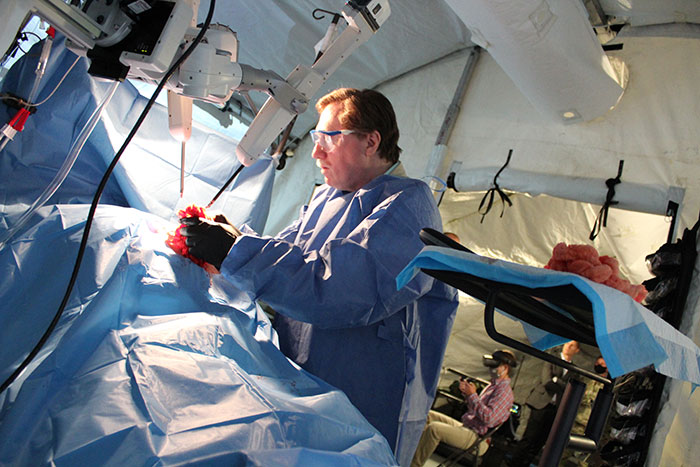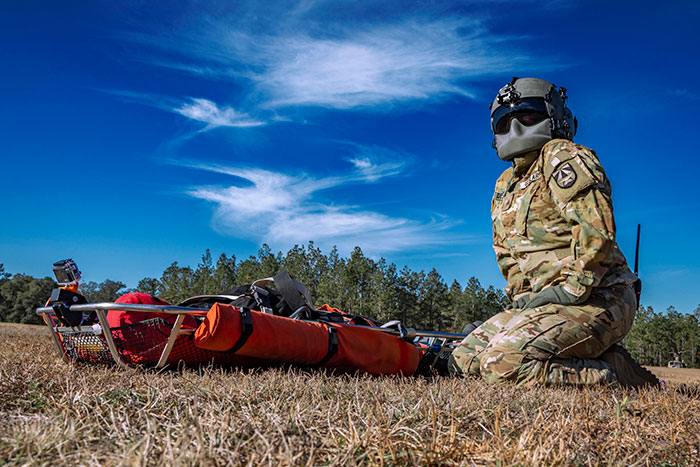Culture, Capabilities Power USAMRDC into Future, Beyond

U.S. Army Medical Research and Development Command scientist Jay Wang was reviewing his notes prior to a recent presentation when he started thinking about innovation, about the kind of thinking required to tackle challenges on the future battlefield.
"You know, Steve Jobs never asked anybody if they wanted an iPhone," said Wang, a product manager for USAMRDC's U.S. Army Medical Materiel Development Activity, referencing the famed former co-founder and CEO of Apple, Inc. "Instead, he saw a need and then created a product to fill that gap."
In so many ways, that unique perspective – the ability to foresee and then provide necessary medical means for the Warfighter – has come to define USAMRDC. For Wang, it's apparent in his work in developing the Medical Hands-free Unified Broadcast tool, an innovative communication platform designed to help share patient information between medics and hospitals during medical evacuations. For the larger command however, it's seen in the overall shared environment – the commitment to fostering the type of vision and capabilities required to protect the most important asset in the military: the Warfighter.
The command's efforts on the fronts of innovation and collaboration can perhaps best be seen in its participation in the Project Convergence 21 event, a joint military exercise running for six weeks from early October to late November at both Yuma Proving Ground, Arizona, and White Sands Missile Range, New Mexico. The event, which featured more than 100 new military technologies from the Army, Navy, Air Force, Marine Corps and the newly-formed Space Force as well, allowed military leaders to judge, grade, and augment the all-domain operations capabilities of the Joint Force. Indeed, as collaboration among the services will be a key element in the future fight, Project Convergence 21 is viewed as critical in helping the Army prepare for the changing nature of warfare.
"Sometimes it's not the strongest or smartest that survive, it's the ones that can adapt the fastest," said USAMRDC Command Sgt. Maj. Victor Laragione during remarks last month at the annual Association of the U.S. Army meeting in Washington, D.C. "How do we innovate? How do we get ahead of the next challenge? How do we do things differently?"

For USAMRDC, those questions drive the daily workload; both informing and shaping the end result while staying focused on the mission. It's that brand of adaptability that has allowed USAMRDC to tackle challenges related to military medicine and, in turn, develop solutions that ultimately save lives.
"It's exhilarating to watch these ideas come to fruition," says said Dawn Rosarius, USAMRDC's principal assistant for acquisition, when asked about her front-row seat for the aforementioned innovation process at USAMRDC.
And yet while the victories have been sizable, there is also a benefit to be found in the occasional scientific setback. Not every product developed for military medical use is viable – indeed, some are never fielded at all. Still others take unusual paths. The MEDHUB, for instance, was an amalgamation of other products that required a more precise, finely-tuned vision – the proverbial "fresh perspective," accompanied by additional research and the blossoming of new partnerships – before it became a truly game-changing technology. The RTS,S malaria vaccine – developed in part by USAMRDC's Walter Reed Army Institute of Research – took more than two decades of development before it was recommended (just weeks ago) by the World Health Organization for use in at-risk children. Far from solely impacting the life of the Warfighter, these solutions have the potential to impact the global community. It is the willingness to commit to a process that allows for learning at all steps of acquisition that truly showcases the strengths of USAMRDC.
Also as a part of Project Convergence 21 event, the USAMRDC's U.S. Army Aeromedical Research Laboratory will present and demonstrate the Load Stability System-Litter Attachment, a device developed by Colorado-based company Vita Inclinata Technologies and designed to stabilize hoist and sling loads in order to reduce spin during helicopter operations. By minimizing said spin movements, retrieval of the litter and the patient becomes safe and faster for both the patient and the attending aircrew. These types of clean, quick evacuations will likely be key to overall force health and resiliency during multi-domain operations.

"The resiliency that I've seen in this command to learn from scientific failures and move forward – it brings me to work every day," says Rosarius. "People might say 'failures – that's terrible' – no, it's great, because we fail fast, we move on, we learn from that and then we move to the next thing."
For USAMRDC, that 'next thing' will likely be a convergence of information technology and networking trends, tools that will – according to the Army's "Force 2025 and Beyond" strategy – likely decide larger courses of action during MDO. Efforts like the National Emergency Tele-Critical Care Network. Developed by the USAMRDC's Telemedicine and Advanced Technology Research Center, the NETCCN – a cloud-based, stand-alone health information management system with the capability of creating "virtual critical care wards" via current handheld mobile devices – has already conducted several thousand live-video exchanges to parts of the globe in need of experienced clinicians.
"From my perspective, what we're doing with NETCCN can easily be transferred to the MDO environment, and that's a benefit to the Force as a whole," said Laragione. "We're doing things we're never done before to get after the fight. And I think we're a lot better postured now than we ever were to fight the next threat, to fight the next pandemic."
In so many ways, that line of thinking represents the life cycle of the mindset that produces game-changing medical products themselves; the freedom to imagine, research, and develop – and do it all over and over again if need be – to deliver the products that are truly needed on the battlefield and beyond.
"The collaboration between the forces and programs has been quite refreshing," said Aimee Dacanay, assistant product manager at USAMMDA, who attended the event in-person. "There is an incredible sense of teamwork and ingenuity in the air; seeing the future technological advancements within communications, defense tactics, and medical [and] patient management on a next-generation network is truly a testament to our dedication to the Warfighter."














